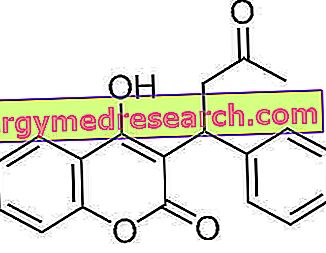Generality
Selegiline is an active ingredient belonging to the class B monoamine oxidase inhibitors (otherwise known by the acronym MAO-B). More specifically, selegiline is a selective and reversible inhibitor of MAO-B.

Examples of Specialty Medicines Containing Selegiline
- Jumex®
- Selecom®
- Egibren®
Therapeutic indications
The use of selegiline is indicated for the treatment of:
- Parkinson's disease;
- Symptomatic Parkinsonisms;
- Primary psycho-organic syndrome.
Warnings
Before starting selegiline therapy, it is very important to tell your doctor if:
- You suffer from cardiovascular disorders such as hypertension, arrhythmias or severe angina pectoris;
- One is suffering from psychosis;
- You suffer, or have suffered in the past, from peptic ulcer;
- You are suffering from severe hepatic and / or renal dysfunction;
- Other drugs active on the central nervous system are being taken;
- One must undergo surgery for which general anesthesia is required.
Furthermore, selegiline should not be used in patients under 18 years of age, since there is no indication for the specific use of this active ingredient in this category of patients.
Following the use of selegiline, side effects may occur which can alter the ability to drive vehicles and / or machinery; therefore, these activities must be suspended while taking the drug.
Finally, it should be remembered that for those who carry out sporting activities, the use of the drug in question without therapeutic necessity is doping and - even if taken for therapeutic purposes - can still cause positivity to doping tests.
Interactions with other drugs
The use of selegiline in combination with the following drugs is contraindicated:
- Sympathomimetics, as there is an increased risk of onset of hypertension;
- < Tricyclic antidepressants, selective serotonin reuptake inhibitors ( SSRIs ), serotonin and norepinephrine reuptake inhibitors ( SNRIs ) and antidepressant drugs in general, due to side effects - sometimes very serious - that could occur in the central nervous system;
- Petidina (an opioid);
- Other monoamine oxidase inhibitors, as serious side effects on the central nervous system and cardiovascular system can occur.
Furthermore, concomitant use of selegiline and oral contraceptives is not recommended, as these may increase the bioavailability of selegiline itself.
The simultaneous use of selegiline and anticoagulants and / or digitalis requires careful monitoring of patients.
However, before starting selegiline therapy, it is essential to tell your doctor if you are taking - or have recently been taken - any type of medication, including prescription drugs, over-the-counter medications, herbal products and homeopaths.
Side effects
Like any other drug, selegiline can cause various side effects, although not all patients experience them.
The type of adverse effects and the intensity with which they occur may vary from individual to individual, depending on the sensitivity of each patient to the same drug.
The main side effects that may occur during selegiline therapy will be briefly listed below.
Nervous system disorders
During the selegiline treatment, the following may occur:
- headache;
- dizziness;
- Dizziness.
Psychiatric disorders
Selegiline therapy could promote the onset of insomnia, sleep disorders and mood changes.
Cardiovascular disorders
While taking selegiline, bradycardia, supraventricular tachycardia and / or orthostatic hypotension may occur.
Other side effects
Other side effects that could occur during therapy with selegiline are:
- Allergic reactions in sensitive individuals;
- Nausea;
- Alteration of blood tests performed to determine liver function;
- Dry mouth;
- Skin reactions;
- Increased sexual desire.
Overdose
In case of excessive doses of selegiline, hypertension may occur.
Therefore, if you suspect an overdose with selegiline, you should contact your doctor immediately and go to the nearest emergency room.
Action mechanism
As mentioned, selegiline is a type B monoamine oxidase inhibitor.
More in detail, this active principle is able to selectively bind, even if reversible, to a specific site of action present in the aforementioned enzymes. The selegilin-enzyme interaction causes an inhibition of the latter which, therefore, is no longer able to metabolize dopamine, thereby increasing its availability and favoring its action.
Parkinson's disease is characterized precisely by reduced dopaminergic transmission in nigrostriatal areas.
Furthermore, when selegiline is administered in combination with levodopa, it prolongs its duration of action thanks to its ability to reduce dopamine metabolism. Because of this ability of selegiline, therefore, it is possible to reduce the dose of levodopa administered, thus contributing to reducing the side effects, but without altering its therapeutic efficacy.
Method of use and Posology
Selegiline is available in pharmaceutical formulations suitable for oral administration in the form of tablets and oral solution.
Treatment of Parkinson's disease and Parkinsonism
For the treatment of Parkinson's disease and parkinsonism, selegiline is available as tablets.
When used as monotherapy, the dose of active ingredient usually administered is 10 mg a day, to be taken in a single dose in the morning, or in two divided doses, one in the morning and one in the afternoon.
When, on the other hand, selegiline is used in association with other drugs for the treatment of Parkinson's disease, the usual starting dose used is 5-10 mg per day, to be taken in a single administration in the morning, or to be divided into two separate administrations (one in the morning and one in the afternoon).
In patients with akinesia and dyskinesia, however, the recommended dose of selegiline is 10 mg a day.
Treatment of primary psycho-organic syndrome
For the treatment of primary psycho-organic syndrome, selegiline is available both as tablets and as an oral solution.
The usual dose is 10 mg of active ingredient per day, to be taken in a single dose in the morning.
Pregnancy and breastfeeding
Given the therapeutic indications of selegiline, this drug is unlikely to be used in patients of childbearing age.
However, due to the potential risks that may exist, the use of selegiline during pregnancy is generally contraindicated.
It is not known whether this active ingredient is excreted in breast milk, therefore, as a precautionary measure, also the use of the drug by breast-feeding mothers is contraindicated.
Contraindications
The use of selegiline is contraindicated in the following cases:
- Known hypersensitivity to selegiline itself;
- If you are suffering from severe motor disorders NOT due to dopamine deficiency;
- If you suffer from gastric ulcer or active duodenal ulcer;
- If you are on therapy with antidepressant drugs of any kind, sympathomimetics, linezolid (an antibiotic) or opioids (such as pethidine);
- If you are taking other monoamine oxidase inhibitors;
- Pregnant;
- During breastfeeding.



